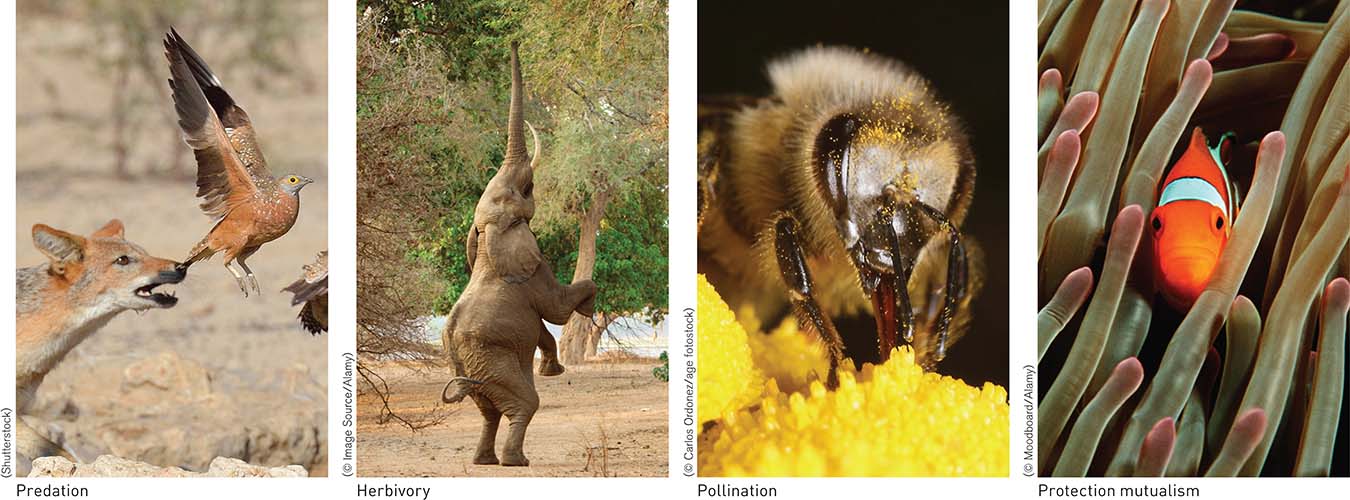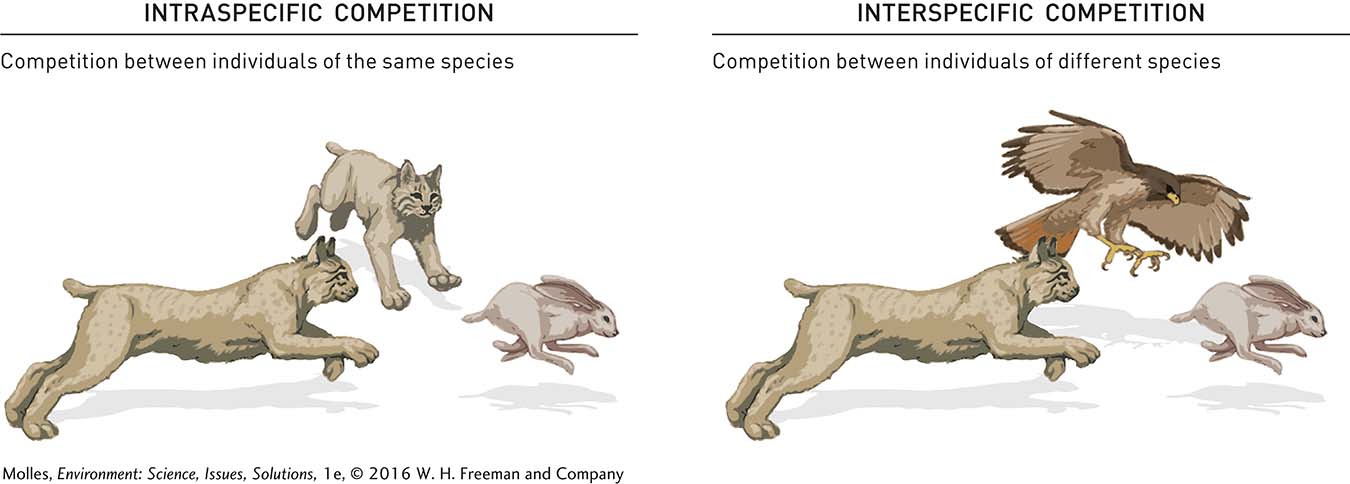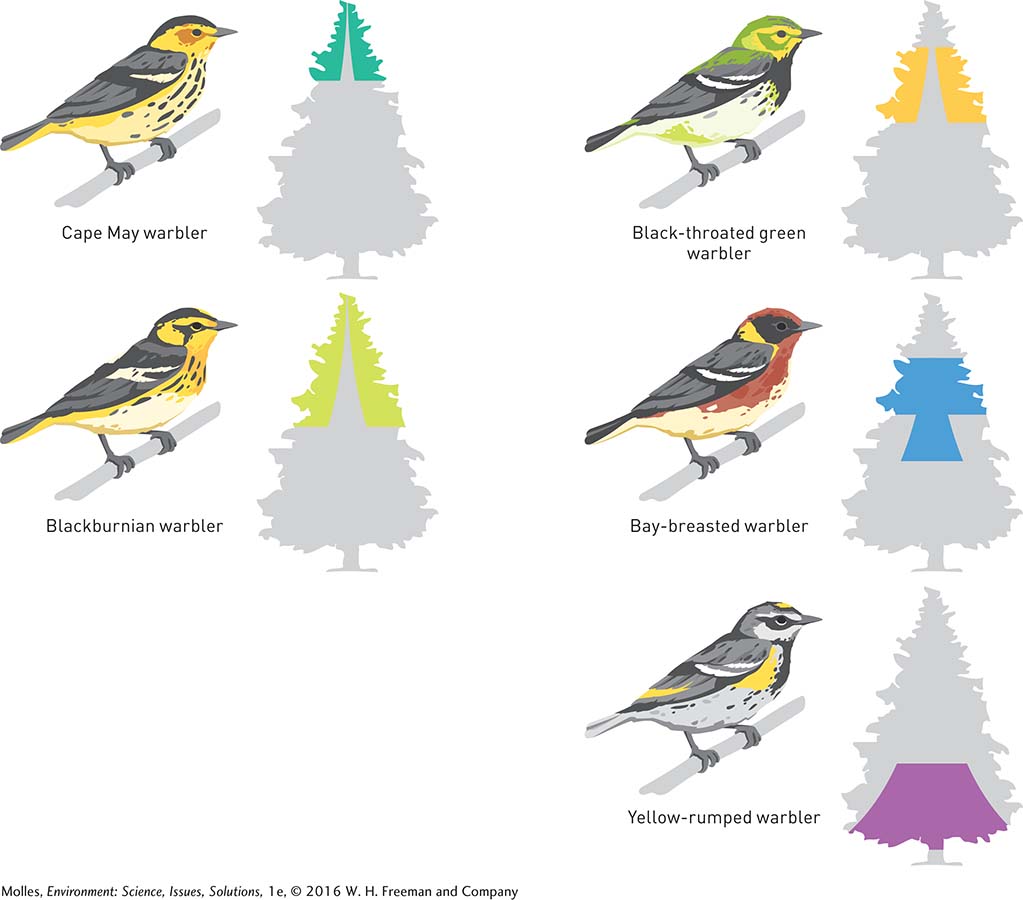3.5 Species interactions define biological communities
ecological community All the species—plants, animals, fungi, and microbes—that exist and interact in a given location.
mutualism Mutually beneficial relationship between organisms.
An ecological community consists of all the species—plants, animals, fungi, and microbes—that exist and interact in a given location. The interactions among the community members, such as those between a predator and its prey, shape ecological patterns and influence the evolution of populations (Figure 3.16). The web of interactions can be baffling. For example, hummingbirds dip their bills into deep flowers to drink nectar; at the same time, they inadvertently pollinate these plants in a mutually beneficial relationship, called a mutualism. Meanwhile, small insects, such as bees and flies, might visit these same flowers and compete with hummingbirds for nectar. If these bees are poor pollinators, then they impose a cost on both the flowers and the hummingbirds. Finally, it’s a little-known fact that hummingbirds sometimes eat insects for protein, so they may well snatch one of these flying insects in their flexible bills!
INTERACTIONS BETWEEN SPECIES IN COMMUNITIES

FIGURE 3.16 Ecological communities are characterized by a complex web of interactions among species. (a) A black-backed jackal hunting sand grouse in Africa typifies predation, the killing and eating of another organism for food. (b) An elephant stripping foliage from a tree shows an herbivore harvesting living plant biomass. (c) Dusted with yellow pollen, a bee is photographed in the act of transporting pollen from one plant to another as it gathers nectar from the flowers it visits. (d) In another mutualism, a tropical anemonefish finds shelter among the tentacles of a stinging anemone for which the anemonefish provides chemical nutrients from its wastes and food scraps.
(Shutterstock) (© Image Source/Alamy) (© Carlos Ordonez/age fotostock) (© Moodboard/Alamy)
Nature is filled with elaborate mutualisms that go beyond pollination. For instance, Acacia ants live inside the thorns of some Acacia trees and protect them from herbivores; in exchange, they feed on a nutrient-rich liquid the plants secrete. Mycorrhizal fungi growing around plant roots help the plants acquire soil nutrients in exchange for energy-rich carbohydrates.
Environmental Requirements and the Niche

Why is a species’ habitat not the same as its niche?
niche A description of the physical and biological requirements of a species.
habitat Where an organism usually lives (e.g., a forest, coral reef, or marsh).
The ecological niche is a description of the physical and biological requirements of a species. A species’ niche includes where an organism lives—its habitat—and its trophic position in the ecosystem, for example, whether it’s a primary producer, a predator, or an herbivore (see Chapter 2 for more on trophic relations). However, the niche may also include such factors as the temperature range the species lives in, its water requirements, as well as when and where it feeds.
For instance, mountain gorilla habitat is mountain tropical rain forest, whereas that of the Bay checkerspot butterfly is temperate grassland. Both are herbivores; however, their approaches to herbivory are quite different. Mountain gorillas feed on more than 140 species of plants, which makes them a “generalist herbivore.” In contrast, Bay checkerspot caterpillars are “specialist herbivores” that feed mainly on just two plant species (Figure 3.17).
CONTRASTING APPROACHES TO DIET

FIGURE 3.17 Because mountain gorillas feed on so many more plant species, the dietary part of its niche is much broader compared with that of the Bay checkerspot butterfly, which has a narrow feeding niche.
The Competitive Exclusion Principle

How are competing businesses, for example, restaurants or car manufacturers, similar to species living in a natural ecosystem? How are they different?
competition Interactions among individuals that depend on the same resources; generally results in reduced growth, reproduction, or survival of one or both competitors.
intraspecific competition Competition among individuals of the same species.
interspecific competition Competition among individuals of different species.
Competition involves interactions between individuals that depend on the same resources, such as food or space, for their survival and reproduction. Where the resources involved are in limited supply, competition for those resources may impact one or both of the competitors by reducing growth rates, reproductive rates, or probability of survival. Competition is most likely to occur between organisms with similar niches, since by definition they have similar resource needs. Because individuals of the same species share the same niche, competition is often strongest among them. This competition is called intraspecific competition, one of the density-dependent factors that regulate populations. Competition among individuals of different species, interspecific competition, is most likely to occur where the organisms have similar niches (Figure 3.18).
COMPETITION WITHIN AND BETWEEN SPECIES

FIGURE 3.18 Both intraspecific (within species) competition and interspecific (between species) competition are important to the ecology of species. The intensity of interspecific competition depends on the amount of overlap in niches between two species.
Page 74
competitive exclusion principle If two species with identical niches compete for a limited resource (e.g., nectar), one or the other will be a better competitor and will eventually eliminate the other species.
Interspecific competition may influence the number and kinds of species that live together in a community. For instance, one species may exclude another from an ecological community and so reduce the total number of species living together. According to the competitive exclusion principle, if two species with identical niches compete for a limited resource (e.g., nectar), one or the other will be a better competitor and will eventually eliminate the other species. It follows from the competitive exclusion principle that when species live together, they generally have slightly different niches.
resource partitioning Coexisting species use different resources, such as food, nesting sites, and feeding areas.
Studies of animals as diverse as insects, birds, fish, rodents, and lizards have shown that coexisting species use different resources, such as food, nesting sites, and feeding areas. Called resource partitioning, one of the best-known examples of the phenomenon occurs among coexisting species of woodland warblers. Up to five species of woodland warbler may live together in the forests of northeastern North America despite the fact that all species are about the same size and all eat insects. Since each species forages for insects in a different part of the trees, however, the spatial aspects of their feeding niches are different (Figure 3.19). Similarly, many hummingbirds coexist in the tropical rain forest, but they have bills of different lengths, which allow them to access different flowers.
Page 75
PARTITIONING OF RESOURCES

FIGURE 3.19 The colored areas in the spruce trees, which show where each species spends at least half of its feeding time, indicate the feeding zones of five species of North American warblers. These differences in feeding zones, that is, feeding niches, reduce competition among the warbler species.
Page 76
Think About It
How might the feeding patterns of the Bay checkerspot caterpillar niche indicate vulnerability of the species to extinction?
Why is intraspecific competition generally stronger than interspecific competition?
3.1–3.5 Science: Summary
Organisms live in populations, which consist of the individuals of a species inhabiting some specified area. Populations vary in distribution and abundance. Smaller populations with limited distributions generally characterize endangered species. Larger species generally have smaller population sizes, when compared with smaller species, and live at lower population densities. Genetic diversity is important to the potential survival of a population because it reflects the potential of a population to evolve and survive in the face of environmental challenges.
There are two basic patterns of population growth: J-shaped, or exponential, growth, and S-shaped, or logistic, growth. Species range widely in life history, a set of evolved adaptations to the environment such as the age at which individuals begin reproducing and the number of offspring they produce. Species controlled by density-dependent factors stabilize at the population carrying capacity and are called K-selected, while r-selected species are often subject to catastrophic mortality from density-independent factors. The ecological niche describes the physical and biological requirements of a species. Species living in the same community that have similar niches are more likely to compete than are species with different niches. According to the competitive exclusion principle, two species with identical niches cannot coexist indefinitely. Species living together in the same community often partition resources, reducing the potential for competition as a result.





